
The pipe organ is a musical instrument that produces sound by driving pressurized air through the organ pipes selected from a keyboard. Because each pipe produces a single pitch, the pipes are provided in sets called ranks, each of which has a common timbre and volume throughout the keyboard compass. Most organs have many ranks of pipes of differing timbre, pitch, and volume that the player can employ singly or in combination through the use of controls called stops.

The Franciscan Monastery of the Holy Land in America is a Franciscan complex at 14th and Quincy Streets in the Brookland neighborhood of Northeast Washington, D.C. Located on a hill called Mount Saint Sepulcher, and anchored by the Memorial Church of the Holy Sepulcher, it includes gardens, replicas of various shrines throughout Israel, a replica of the catacombs in Rome, an archive, a library, as well as bones of Saint Benignus of Armagh, brought from the Roman catacombs and originally in the cathedral of Narni, Italy.
Mathias Peter Møller, commonly known as M.P. Möller or Moeller, was a prolific pipe-organ builder and businessman. A native of the Danish island of Bornholm, he emigrated to the United States in 1872 and founded the M.P. Moller Pipe Organ Company in Greencastle, Pennsylvania, in 1875. The city of Hagerstown, Maryland, took notice of Möller's early successes and induced him to move his business there in 1881 to help make it a viable business center in Western Maryland. The company remained in business in Hagerstown. until 1992, with hundreds of employees at its peak and a lifetime production of over 12,000 instruments.
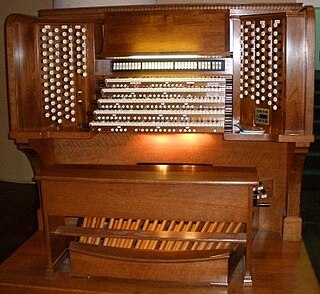
The symphonic organ is a style of pipe organ that flourished during the first three decades of the 20th century in town halls and other secular public venues, particularly in the United States and the United Kingdom. It has roots in 19th-century Europe, and is a variation of the classical pipe organ. It features expanded capabilities, with many pipes imitative of orchestral instruments, and with multiple expressive divisions and organ console controls for seamlessly adjusting volume and tone, generally with electric organ actions and winding. These expansions let the organist approximate a conductor's power to shape the tonal textures of Romantic music and orchestral transcriptions. These organs are generally concert instruments as opposed to church organs. The symphonic organ has seen a revival in the US, Europe and Japan, particularly since the 1980s.
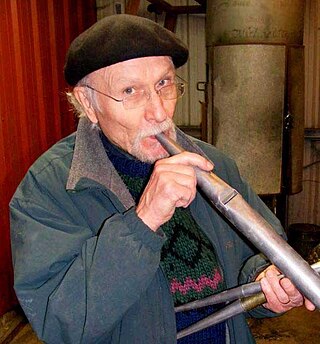
John Burlin Brombaugh is an American pipe organ builder known for his historically oriented tracker action pipe organs.

Austin Organs, Inc., is a manufacturer of pipe organs based in Hartford, Connecticut. The company is one of the oldest continuously-operating organ manufacturers in the United States. The first instruments were built in 1893 with the Austin Patent Airchest, and many remain in fine playing condition to this day.
E. and G.G. Hook was a pipe organ designing and manufacturing company, located in Boston, Massachusetts, which operated from 1827 to 1935. It was started, and originally run, by brothers Elias and George Greenleaf Hook.
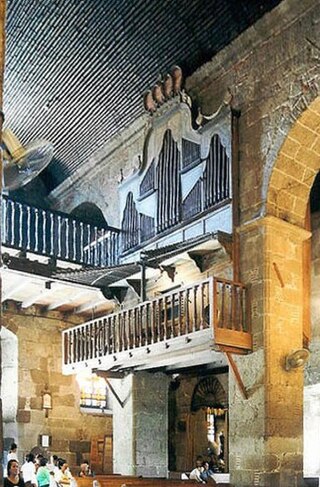
The Las Piñas Bamboo Organ in St. Joseph Parish Church in Las Piñas, Philippines, is a 19th-century church organ. It is known for its unique organ pipes; of its 1031 pipes, 902 are made of bamboo. It was completed after 6 years of work in 1824 by Father Diego Cera, the builder of the town's stone church and its first resident Catholic parish priest.

Saint Mark's Episcopal Church, at 1625 Locust Street in Rittenhouse Square, Center City, Philadelphia, Pennsylvania, is an Episcopal church in the Anglo-Catholic tradition. It is part of the Diocese of Pennsylvania.
Otto Hofmann was a pipe organ builder and the first American president of the International Society of Organbuilders.

The St. Frances Xavier Cabrini Shrine is located at 701 Fort Washington Avenue between Fort Tryon Park and West 190th Street, with a facade on Cabrini Boulevard, in the Hudson Heights neighborhood of Washington Heights in Upper Manhattan, New York City. It is dedicated to Saint Frances Xavier Cabrini, who in 1946 became the first American citizen to be canonized by the Roman Catholic Church.

Olympic Organ Builders was an importer and custom fabricator of tracker action pipe organs in Seattle, Washington from 1962 through the 1970s. The company built approximately 25 organs for churches and schools located the Puget Sound and Eugene Oregon in the period from 1967 through 1970.

Charles Marie Courboin (1884–1973) was a Belgian–American organ virtuoso who enjoyed popularity during the 1920s. During this time he was engaged by department store magnate Rodman Wanamaker to oversee the second enlargement of the Wanamaker Organ. He added the huge string and orchestral sections bringing it to 461 ranks and 28,482 pipes. He also served as Director of Music for St. Patrick Cathedral, New York City from 1943 until his retirement in 1968.
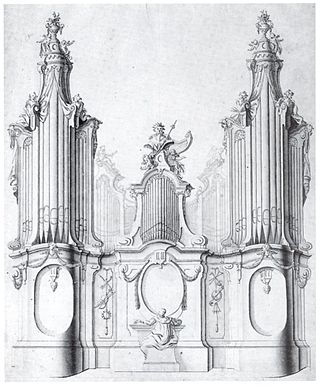
Organ building is the profession of designing, building, restoring and maintaining pipe organs.
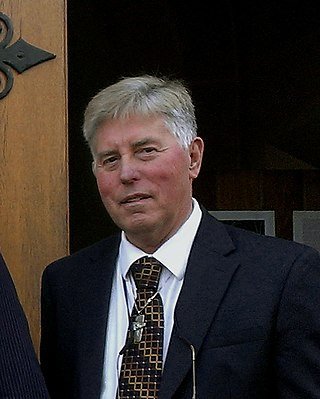
David P. Dahl is an American professor, composer, pedagogue, organist, church musician, organ clinician, and advisor. He is also one of the founders of Olympic Organ Builders.
Müller & Abel was an American firm founded in New York City which was notable in the field of building pipe organs. It operated from 1893 to 1902.
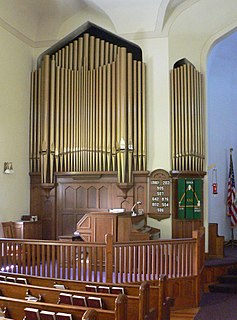
Hinners Organ Company was an American manufacturer of reed and pipe organs located in Pekin, Illinois. Established in 1879 by German-American John Hinners, the firm grew through several partners, becoming Hinners & Fink in 1881, Hinners & Albertsen in 1886, and Hinners Organ Company in 1902. In the 1920s Hinners established a subsidiary, the Illinois Organ Supply Company, which mass-produced parts for Hinners and other firms. Business declined in the 1930s due to the Great Depression, changing technology, and increasing competition. Hinners became a service company in 1936 and closed in 1942.

Xaver Wilhelmy is an inventor, designer and certified pipe organ builder who was the first in the world to create organ pipes from glass. Wilhelmy created the Wilhelmy American Flag Glass Pipe Organ, the first pipe organ in the world with pipes made entirely from glass.

Farrand & Votey Organ Company was a nineteenth-century manufacturer of pianos, reed and pipe organs, and player pianos located in Detroit, Michigan. It evolved from William R. Farrand and Edwin S. Votey, hence the name of Farrand & Votey. The company is the development of the old Detroit Reed Organ Company that was originally bought out in 1881. The Farrand & Votey Organ Company produced 7,200 instruments a year by 1889. The company made huge organs on special order contracts. In 1891 the company built a monumental 2,700 pipe organ for the Detroit's First Presbyterian Church. In 1893 it built a huge organ for the Chicago World's Fair, where it was played in recitals by world-renowned organists. In 1897 it built the nation's largest pipe organ. The company dissolved in 1897 and split up into two separate companies of the owners, each making their own style of organs.














